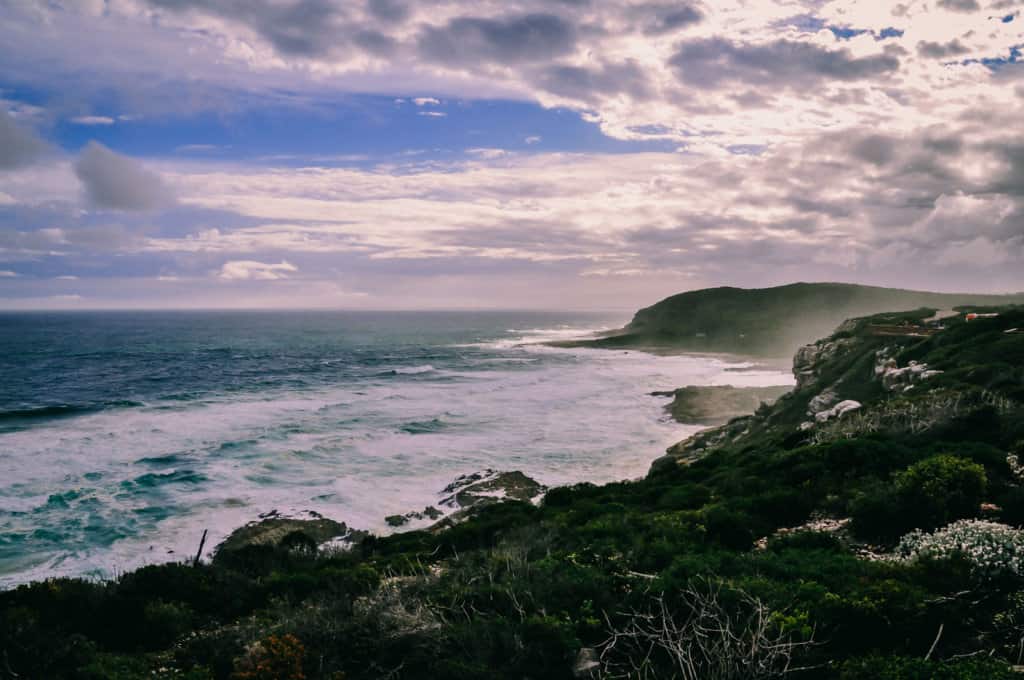Road trip | Garden Route | South Africa
The Garden Route in South Africa:
10 day Road Trip Itinerary
Text | Anninka Kraus
Photography | Tobias Kraus

South Africa Western Cape
The Garden Route is one of South Africa’s most scenic drives as it stretches 300 kilometers along a stunning coastline from Mossel Bay to Storms River in Tsitsikamma National Park.
This route is located in South Africa’s Western Cape region that with its surf-thrashed beaches, charming coastal towns, indigenous Southern Afrotemperate Forest, mountains, and wildlife sanctuaries guarantees an epic road trip.
As you plan your Garden Route road trip, keep in mind that every Garden Route itinerary is a little different, so it’s important that you find one that suits your interests. We love hiking and spending time in the outdoors, not so much adrenaline-packed activities like bungee-jumping and shark cage diving, and this itinerary reflects our interests.
jump ahead
The Garden Route stretches 300 kilometers along a stunning coastline in South Africa’s Western Cape region from Mossel Bay to Storms River in Tsitsikamma National Park. These are the top places to visit on your 10-day Garden Route road trip:
Day 1: Cape Town
Day 2-3: Discover South Africa’s 3 Capes: Cape of Good Hope, Cape Point, and Cape Agulhas
Day 4-5: Mossel Bay and Knysna
Day 6: Plettenberg Bay and Robberg Nature Reserve
Day 7: Birds of Eden, the world’s largest free flight aviary and bird sanctuary
Day 8: Tsitsikamma National Park and Hikes at Storms River Mouth
Day 9-10: Oudtshoorn – ostrich capital of the world – and Inland Route 62
View of Cape Town from Table Mountain.
Garden Route map
what to expect.
Surf-thrashed beaches, indigenous Southern Afrotemperate Forest, mountains, and wildlife sanctuaries
Start and finish your Garden Route road trip in Cape Town and enjoy the famous views of the city from the top Table Mountain
Visit South Africa’s Famous Capes: Cape of Good Hope, Cape Point, and Cape Agulhas
Explore the charming coastal towns dotting the route, like Knysna and Plettenberg Bay
location & visitor information.
When to go on a Garden Route road trip: South African spring and summer (October – April) is the best time to drive the Garden Route. In the summer months, from October to March, you’ll have warm weather and long days.
How long to spend on your Garden Route road trip: Mossel Bay is 4.5 hours by car from Cape Town, where most visitors to South Africa will arrive, so we’ve adjusted this guide to the Garden Route into a 10-day round trip from Cape Town.
If you’re starting from Port Elizabeth and want to only focus on a Garden Route road trip, you can easily skip the Cape Town and Capes (Cape of Good Hope, Cape Point, and Cape Agulhas) sections. Storms River is a short 2-hour drive from Port Elizabeth, so starting from PE, you can cover Knysna, Plettenberg Bay, Mossel Bay, and Oudtshoorn in a couple of days.
To truly immerse yourself in this stunning region in South Africa, however, it’s best to allow at least a week for your Garden Route road trip. This 10-day itinerary also grants a little rest in between because we didn’t feel like rushing this epic road trip.
The best way to explore the Garden Route: Exploring the Garden Route on four-wheels is easily the best way to do – it’s a fantastic self-drive journey. All major car rental agencies have rental locations throughout South Africa.
day 1
Arrival in Cape Town
Some places have been on our bucket list for years and while cities such as New York, Vancouver, and Melbourne are too far away to visit over a long weekend, this excuse doesn’t work as well for the fact I have never set foot in Barcelona despite living in Berlin. However, far worse in my opinion is that while I have travelled extensively, I seem to have neglected an entire continent, and one that is moreover, reasonably close to home. It is in any case closer than Australia or New Zealand where I have been regularly.
It was time to stop finding excuses and finally visit the place that held a great fascination for both Tobi and I … Africa!
Our curiosity about Africa was sparked a long time ago, fuelled by notions of ample wildlife grazing on barren steppe dotted with lone acacias, stories of spirit worlds shared around a campfire, disjointed snippets of a difficult past and present taught in history class, and of course the news. We landed in Cape Town filled with eager anticipation to discover this, to my mind, profoundly mysterious whole other world. Cape Town itself didn’t fit any of those exotic notions, it was in fact almost disappointingly normal, and can be comfortably explored on a red sightseeing double-decker bus. We frequently hopped on and off along its route that highlighted the virtues of Cape Town set against the ever-present dominating backdrop of the city’s storied Table Mountain.
After gazing at this mountain from all parts of the city, we stumbled off the bus at stop 13, the Lower Cableway Station. Most people wandered off to the cableway – lovingly call fondue pot because of its Swiss built gondolas, imported in 1997 – but we looked forward to some exercise after the long-distance flight and started on a rewarding 2-hour hike, climbing 700m in altitude, to the level plateau. At the top, 1086m over Cape Town, the city sprawling at our feet spilled forward towards the rugged coastline, beyond which lay the sparkling Atlantic Ocean.
The bright sunshine was deceptive for chilly winds raced across the plateau with astonishing strength. Strong winds appeared to be ever-present in Cape Town and in that regard, it reminded me of Wellington, New Zealand, where pilots are known to need three landing approaches before the wheels of the plane, constantly buffeted by churning gusts, finally touch the runway. On our approach to Cape Town International Airport the day before, the plane also swayed badly in the turbulence, but our pilot landed the plane without difficulty, so I suppose Wellington’s wind is even worse, or the runway too short.
The view from Table Mountain is included in the list of the New 7 Wonders of Nature chosen along with Halong Bay, Iguazu Falls, Komodo, and the Amazon River by more than 500 million votes around the world. While I always consider such rankings restrictive and highly subjective, I won’t challenge describing the iconic backdrop to Cape Town and views from its top as a wonder of nature. They are truly spectacular.
Within five minutes we glided back down the escarpment in one of the revolving fondue-pot cable cars and hopped back on the bus to stop 15 – the beach. It was beautiful and one of an impressive abundance of white sandy beaches stretching along Cape Town’s coastline. The shore is arguably the city’s most arresting feature besides Table Mountain and the docklands. It was October – that is spring in South Africa and the days were not yet at their warmest – so despite frothing waves rolling across the turquoise sea, sunshine, and an air temperature of 24 degrees, we passed on a plunge in the 16-degree cold water. The many surfers riding the waves wore wetsuits, not without reason.
For dinner we went to an area of the docklands called Victoria and Alfred Waterfront. At first, when we were strolling along the boardwalk past fashionable boutiques and fine dining restaurants, it all seemed rather consumption-oriented and somehow superficial. But on closer inspection, the charm of the historical harbour and the gritty working port added a down-to-earth touch to the relaxed atmosphere of a hedonistic, sophisticated crowd enjoying sundowners whilst indulging in views of the harbour, blurred contours of Table Mountain, and the city’s halo of dazzling lights at night.
related | Hike Table Mountain and Lion's Head
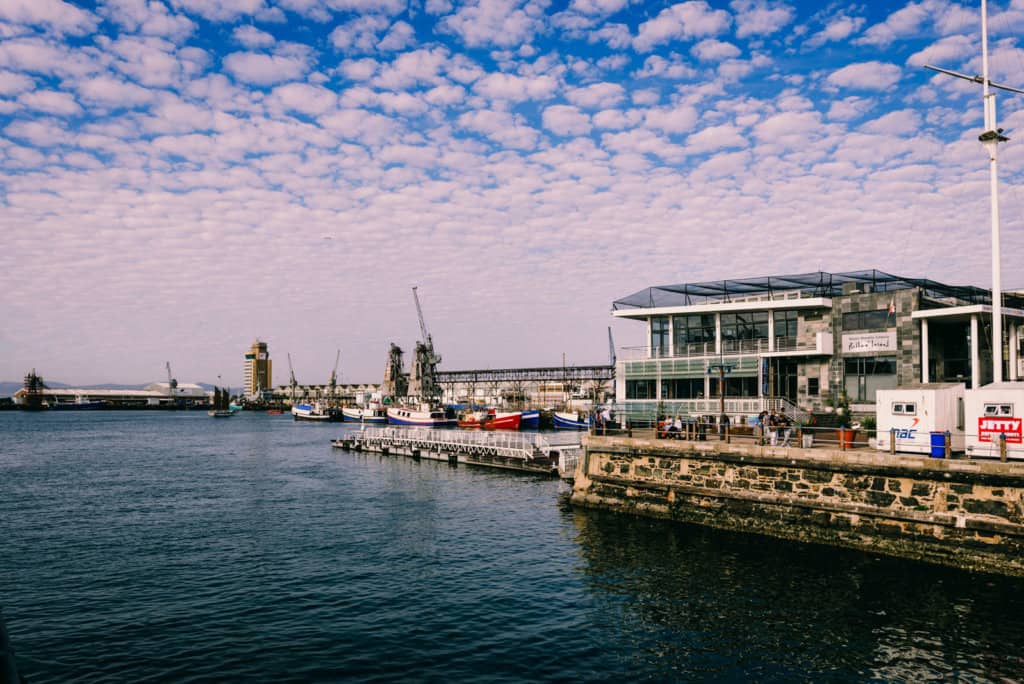
Cape Town's Victoria & Alfred Waterfront is located in South Africa's oldest working harbour.
days 2-3
Discover the 3 Capes in South Africa: Cape of Good Hope, Cape Point and Cape Agulhas
Shrugging off the outskirts of Cape Town in a small Hyundai i20 (we would definitely not be going off-road in this tin can, not voluntarily at least) we followed the western shoreline of the Cape Peninsula towards Cape Point and the Cape of Good Hope.
Past Hout Bay we arrived at the start of Chapmans Peak Drive, a famous 9-kilometre scenic drive winding along the rocky coastline, along which our guide book promised fantastic scenery. This promise was indeed fulfilled by a view of violent waves rushing up rugged cliffs, engulfing them in a foamy bubble of white spray several metres high, alternating with unspoiled, deserted beaches.
Past Scarborough the road turns inland and traverses the peninsula to its very tip that forks into Cape Point in the east and the Cape of Good Hope, Africa’s most south-westerly point. At Cape Point, which was decidedly touristy, the Flying Dutchman funicular railway ferried carloads of tourists up a gentle incline to the lighthouse towering atop sheer cliffs. We decided to walk up and a little further to a cliff jutting out into the ocean as the most impressive view of all was from here looking back at the lighthouse. I wondered how the lighthouse survives those notorious storms unscathed considering how fragile and exposed it looked perching there on the very edge of the cliff before the escarpment plunges into the sea.
We continued on to the Cape of Good Hope, which was a rather unspectacular promontory and attracted fewer tourists, yet its infamy as a graveyard for shipwrecks was intriguing. I imagined fearsome tales of treacherous waters and violent gales while taking some photos of us with its famous signpost. Our guidebook lured us 150 kilometres further southeast to Africa’s southernmost point, Cape Agulhas.
This turned out to be nothing more than another signpost, a survey marker on a rocky coastline, yet we still thought it worth a visit just to stand at the point where the Atlantic and Indian oceans converge while entertaining the notion that this mass of water is all that stands between the Cape and Antarctica.
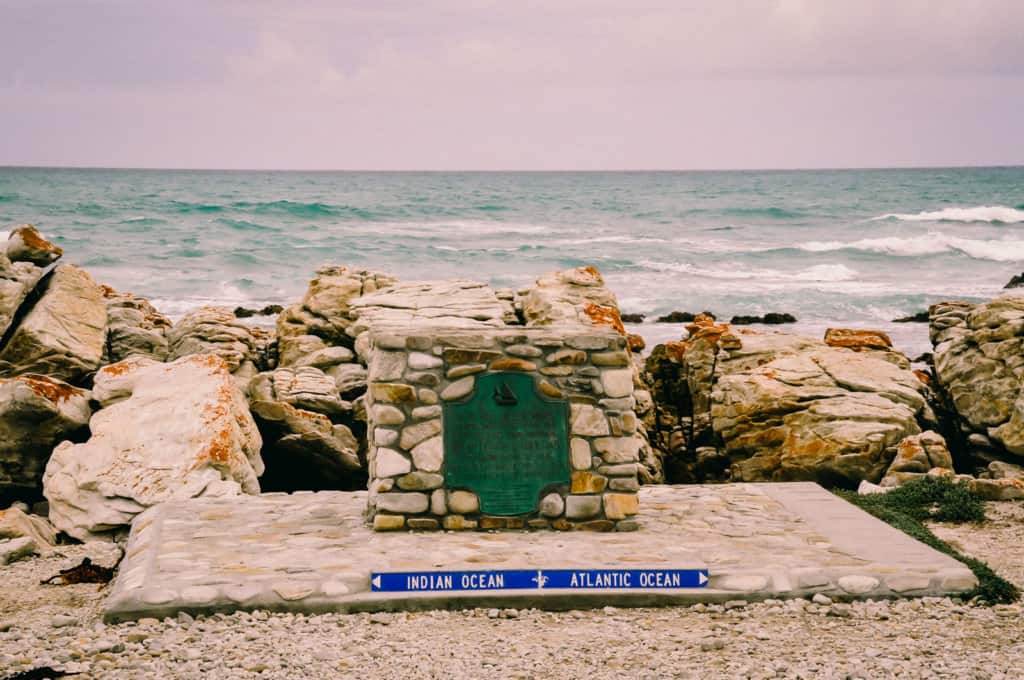
Cape Agulhas is the southernmost point of the African continent and marks the divide between the Atlantic and Indian Oceans.
Our first encounter with the aftermath of apartheid
Apartheid was officially abolished in South Africa in mid-1991 and Mandela elected president in 1994, yet its troubling legacy remains ever-present, even now, almost twenty years later. While we were not naive enough to think that legislations would change a country overnight, we were surprised by the extent to which the aftermath of apartheid still appears to influence everyday life in South Africa.
The lives of coloured and white South Africans hardly ever seemed to touch – not in the suburbs, not in the primary school classes enjoying an outing at Betty’s Bay penguin colony, nor in the restaurants, busses, cafes, or markets. While social ostracism and discrimination on the grounds of race, gender, sexual orientation, religion, and basically any other characteristic that makes us unique happens in most places, we’d never experienced such rigid segregation and found it disconcerting and foreign.
Being German, our history lessons are rife with the most shameful examples of discrimination and unspeakable injustice inflicted on our own population and the rest of the world, and I was surprised at how unprepared I was for the blatantly obvious segregation in South Africa. Nothing I had previously experienced compared.
Townships consisted of vast sprawling slums of shabby corrugated metal huts in direct juxtaposition with predominantly white neighbourhoods resembling nuclear power plants – electrified fences topped with coils of barbed wire, jagged shards of glass protruding from concrete walls, and military style alarm systems – guarding artificial enclaves of wealth, security, and dissociation in voluntary confinement. But we were strangers in a foreign place and have no idea how South Africans themselves perceive the changes and speed at which society adapted to the new legislation of 1994.
Germany is often dubbed a service wasteland, and rightly so for in some restaurants it feels like you could play a full game of chess before attracting the attention of a waiter. But South Africa it seems is the exact opposite. Even at a basic 3-star hotel in Cape Town two porters helped with our luggage while a third kindly handed us a glass of freshly squeezed orange juice, and the next morning four waiters dashed around the breakfast room trying to accommodate everyone. At the gas station we waited while an attendant pumped fuel for us and even the cashiers bagged our groceries at the supermarket check-out. While this is probably common practise in many countries we’re used to cashiers at Aldi pushing groceries our way faster than we can bag them.
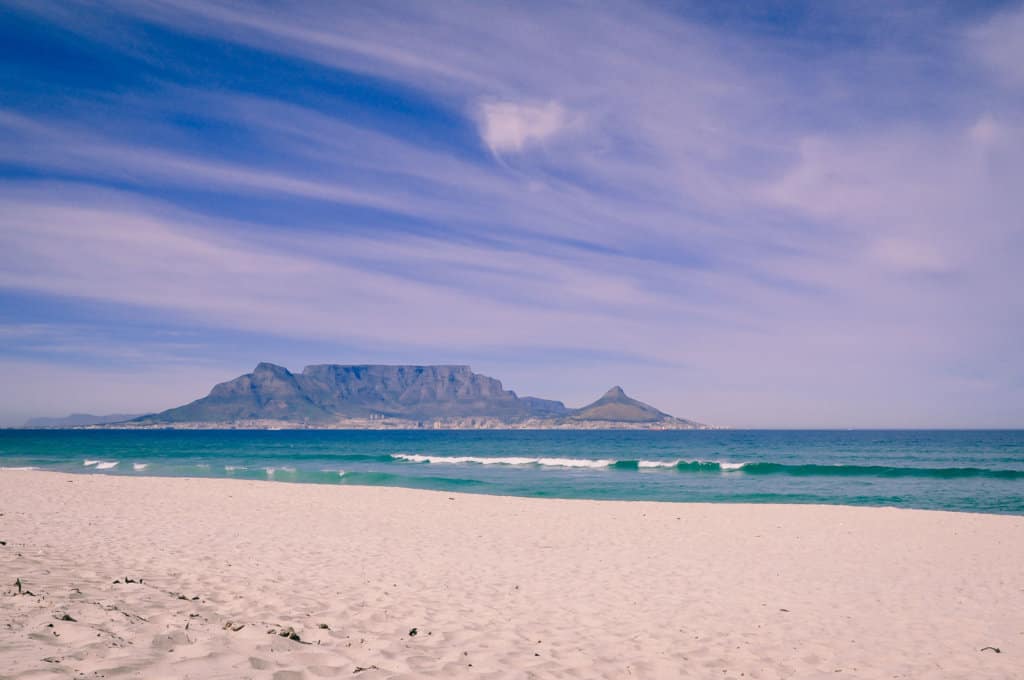
days 4-5
Mossel Bay and Knysna
We headed east towards Port Elizabeth and promptly came across road works. Several traffic controllers stood waving red and green flags to navigate traffic through a single-lane stretch of road while I watched wide-eyed as they stood dangerously close to speeding cars.
My arms fall off after an hour’s aerobics (without weights) and these workers waved flags for hours with their arms extended with no protection from the sun. Two other things also crossed my mind. Firstly, what must the minimum wage be for it to be cheaper to hire a dozen flagmen in place of a set of temporary traffic lights and secondly, I noticed that there wasn’t a single white South African among the workers, or for that matter among the many staff we had come across in the hotels, supermarkets, and petrol stations. White South Africans only make up about 9% of the population but we saw surprisingly few.
Mossel Bay and Knysna are small coastal towns along the Garden Route that cater to tourists but have retained their authentic charm. We arrived in Mossel Bay first, which is located halfway between Cape Town and Port Elizabeth. After strolling along its waterside promenade, we explored parts of the 13.5km St Blaize Hiking Trail that winds along the cliffs westwards from Cape St. Blaize Lighthouse and rewarded us with breath-taking views of high waves mounting steadily and then rushing toward the shoreline.
In Knysna we came upon Thesen Island, an offshore marina development spread over 90 hectares and linked by a causeway and bridge to the mainland. While its location, classy boutiques, an oyster bar buzzing with a happy crowd, sea views, and proximity to the water were stunning, it was also obviously an artificial haven, a neighbourhood carefully groomed, tucked away from the general public, and catering to a very privileged (and exclusively white) crowd. The residential area was guarded by a 24-hour security gate and only accessible to residents and their visitors but we were allowed to wander around the public areas.
On their website Thesen Islands estate management pays tribute to a glorious past where everything was lovely, secure, and kids played outside (what century are they talking about?). Apparently nowadays everything is bad. Directly quoting from their website ‘Fast-forward some decades. Things have changed. You probably have kids or grandchildren of your own. You constantly worry about their safety. They can’t walk or cycle to school or to their friends and you mostly drive them wherever they need to go. They spend most of their time indoors in front of the TV or computer and they don’t get enough exercise. Your home is permanently locked, and the alarm is switched on, even when you are inside. You don’t really know your neighbours and you hardly ever see them. Welcome to suburbia 21st century style!
My first reaction was one of disbelief, perhaps because my experience is so wildly different. I just could not identify with the described scenario at all. While we don’t have kids, friends of ours do and their kids play outside all the time without anybody worrying about their safety. At our last home, a flat in Berlin on the fifth floor, I never worried about safety either. I left the windows open while I was at work, regularly forgot to lock the door (which meant anybody could just turn the doorknob and walk right in), and for alarms, I wasn’t even aware that they existed for private homes. And that was after somebody had broken into our first home in Berlin, a ground floor flat. That would certainly not have happened on Thesen Island, which seemed like an isolated world inside a snow globe – but with sunshine instead of snowflakes – promising a happy, secure, and exclusive life.
I do realise that my initial reaction – dismissing the concern of South African residents for safety as paranoid – was very naive and ignorant, but as a tourist, one is lulled into a false sense of security here, as at first glance there is no perceptible difference to our safety in Central Europe. Despite South Africa being the country with the highest rape crime rate per capita in the world and ranking in the top 10 countries for intentional homicide we never felt threatened during our entire stay.
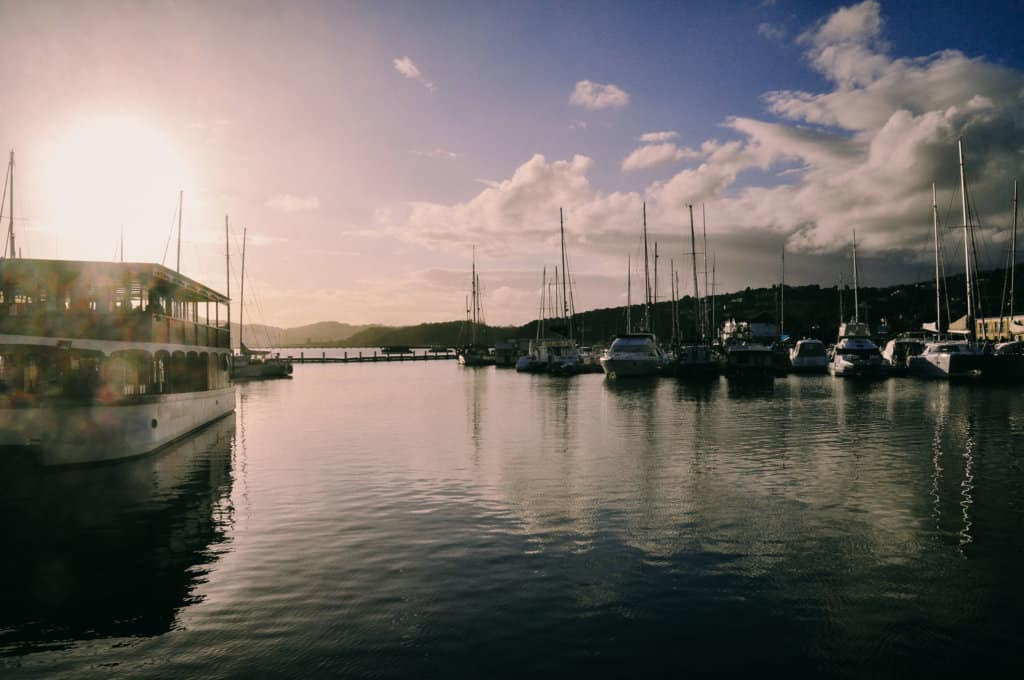
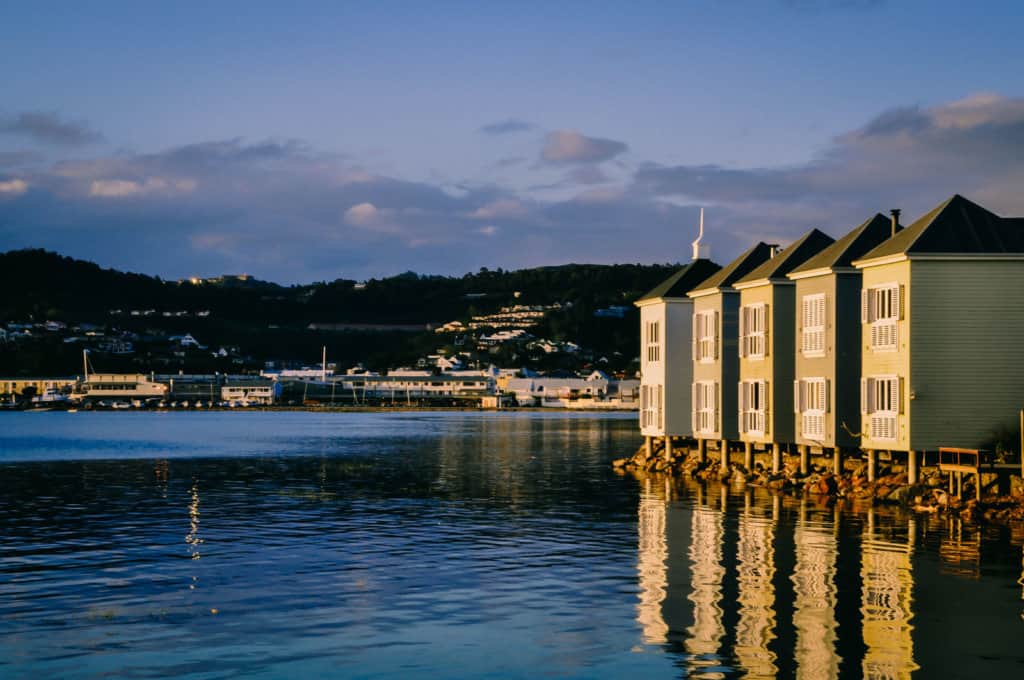
day 6
Plettenberg Bay
Plettenberg Bay, a two-and-a-half-hour drive west of Port Elizabeth, boasts a long sweeping arch of beach, and seemed a prosperous place that on summer weekends drew tens of thousands of Cape Towners who own holiday homes in ‘Plett’. Our hostel recommended Robberg Nature Reserve, a rocky promontory 8km south of Plettenberg Bay, for a short hike.
We set off at once but by the time we arrived at the trailhead it was already late afternoon and we opted for the second longest of three circular trails, the 5.5km Witsand Circuit, skirting the northern ridge of the peninsula. The path closely traced the cliffs that fell off sharply to waves rushing unspoilt coastline. The sight of the Cape fur seals and screeching seabirds dancing on the waves below was spectacular but didn’t prepare us for the beauty of Witsand Dune.
On the map the contours of this sandy tip look much like a boot – not Italy’s classy high heel boot, but more like a clunky hiking boot – stepping into the ocean. In real life it looked nothing like a boot of course but like a dune dropping away to a sandy corridor stretching into the sea that was bathed by the ocean on either side. While one beach is pretty, two back to back was paradise and not a soul in sight.
related | Hike in Robberg Nature Reserve
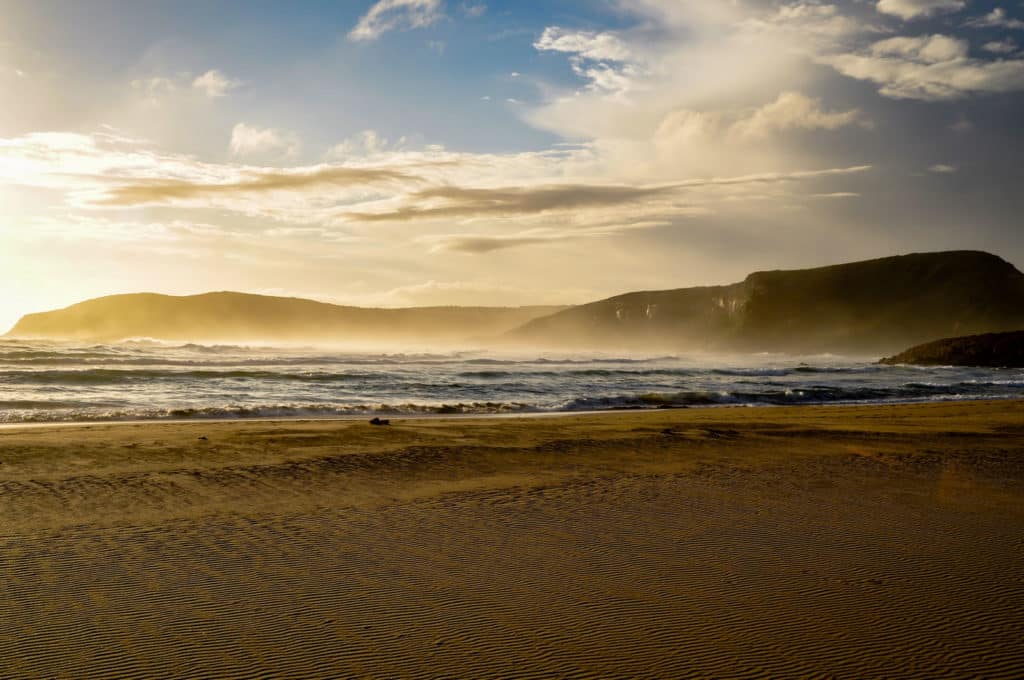
day 7
Birds of Eden
Back on the road, we visited the world’s largest dome, called Birds of Eden, a half-hour out of Plettenberg Bay. It is noteworthy for its sheer size alone, consisting of a 3.2 hectares free flight bird sanctuary which is home to over 3500 birds from 200 species.
Though I vehemently oppose the captivity of birds in principle, this enormous aviary (“where previously caged birds can live a life of free-flight in a habitat as large and natural as possible”) was no ordinary bird cage. I’ll usually start yawning if someone mentions bird watching, but during the two-hour walk along a 1.2 km wooden walkway through rainforest, across suspension bridges, and past waterfalls, I was totally captivated by the beauty of native African and other exotic birds playing hide-and-seek in the foliage of indigenous South African trees (Afromontane Forest).
Several times during our visit all birds suddenly became airborne and I watched fascinated as the cranes, flamingos, ibis, and parrots circled in colourful brush strokes below the mesh, screeching at the top of their lungs at some perceived danger.
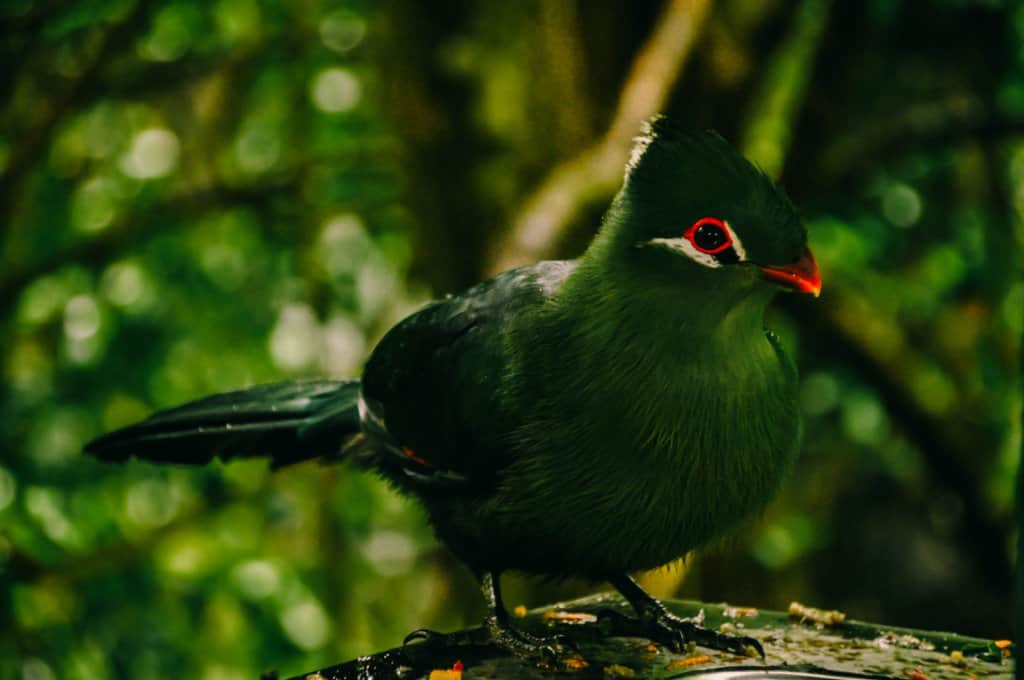
Birds of Eden is the world's largest free flight aviary and bird sanctuary and home to over 3,500 birds.
day 8
Tsitsikamma National Park
Tsitsikamma National Park marked the end of our road trip eastwards and turning point back towards Cape Town. Storms River Mouth is located at the eastern end of the national park, at the end of a 10km cul-de-sac, and is the starting point of many hiking trails.
Even the shortest, the 2km Mouth Trail, was full of variety – beaches, three suspension bridges (one spanning 77m across the Storms River Mouth), and a boardwalk winding through coastal forest offering sweeping vistas of the shoreline. We enjoyed the scenery so much that we came back a few years later to walk the spectacular multi-day Otter Trails that winds along the rugged coastline between from Storms River Mouth in the east to Nature’s Valley in the west.
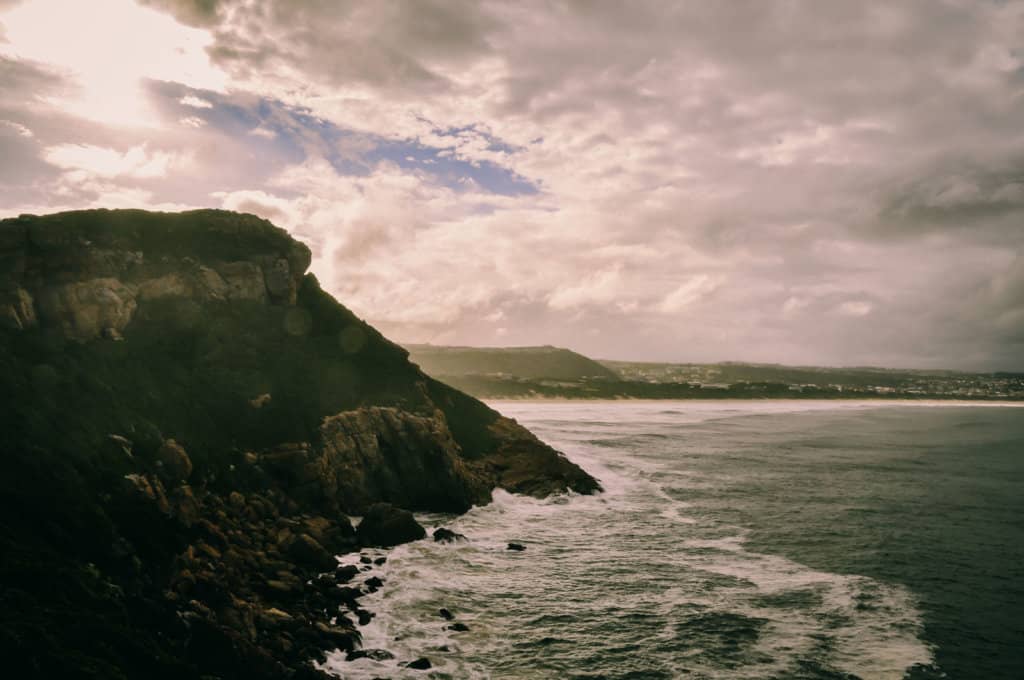
days 9-10
Oudtshoorn - ostrich capital of the world & Route 62
From Storm River, we continued inland towards Oudtshoorn, itself an inconspicuous town on Cape Route 62, but ostrich capital of the world and home to 90% of the world’s ostrich population. As few ostriches (the largest living bird species) walk about on German roads – none actually – we were keen to see one close-up, which was easily done as a great many ostrich farms were daring tourists to pet, feed and ride the birds. Or you can stand on an ostrich egg – the 1.5mm eggshell indeed withstood Tobi’s weight, but imagine the look on his face if it hadn’t. That was rather harmless fun, I thought, but whoever thought of the macabre sports of ostrich riding?
When a ranger asked for volunteers, hands shot up quickly in the stands but few were below the maximum weight of 75kg that was allowed. One lucky volunteer was chosen at random and scrambled into the pen. Meanwhile a poor bird had a hood pulled over its head because it would have bolted in fright at the sight of a tourist walking towards it, as a ranger explained. But even with the hood this poor bird then raced around like crazy with a tourist on its back holding on for dear life. The sight was hilarious, but the discomfort of the bird was not. Apart from the ostrich riding, visiting the farm was great fun. We watched ostrich chicks hatch in an incubator, learned that the males look after the young, and that their tiny brain fits on a teaspoon.
At the recommendation of our B&B hosts, Huw and Zoe, we went to Buffelsdrift Game Lodge, a private game reserve 10 minutes out of Oudtshoorn, for dinner. Though the food was delicious, it paled in comparison to the setting – we ate bathed in the warm light of a glowing orange sunset on their beautiful veranda elevated on stilts over a large waterhole that attracted hippos and antelopes at night.
The next morning, after serving a delicious breakfast, Zoe sat down to talk with us. She is South African born and raised and was happy to tell us a little about her country. ‘Crime, drugs, and corruption are the country’s greatest challenges,’ she told us. She believed that when apartheid was abolished in 1994 with the election of the first black government, this government’s promise of prosperity – a house, a car, and much more – for all Africans, sadly omitted the word ‘opportunity’. They were promising that everybody would be given the opportunity to prosperity but only if one was prepared to work hard. Instead many Africans were simply expecting the government to deliver on how they had understood their promise, waiting for what they believed was their proper due, which led to frustration and discontent when that did not eventuate.
She told us that one major problem was teenagers skipping school to earn some Rand (South Africa’s currency) as a parking guard or petrol station attendant, as this was more appealing to them in the short term. These Rand though were all too often not spent on food but drugs and alcohol, a downward spiral often difficult to escape. In her opinion it will take at least one more generation to change the currently prevalent mind-set of a society where everyone feels accountable only for their own well-being and chances.
Ideally every child would receive the necessary support from home to make use of the country’s opportunities, but how, she pointed out, were South Africans at the bottom end of the salary scale supposed to make a living and support a family. The minimum wage of 12 Rand an hour (barely 1 Euro at our time of visiting) leaves much of the population earning 10 Euros a day for 10 hours of work or 300 Euros at the end of the month if they work every day including weekends. That is completely insufficient in a country where living expenses are only a quarter to a third lower than in Germany. Without trivialising poverty in Europe, the definition of ‘being poor’ here is a very different and much starker.
Equally foreign to us was the omnipresence of corruption that Zoe talked about. Zoe and Huw met all the requirements to obtain a liquor license for their B&B and had applied to the responsible officials many times but they refused to bribe said officials. They had been waiting in vain for three years as without a bribe there would be no license. Anything from a driver’s license, handymen, any kind of official formalities, water, gas, and electricity – the list goes on – were all services that would drag on forever or be refused outright if bribe money didn’t change hands. Zoe and Huw wanted no part in corruption, but Zoe admitted that the daily struggle to get anything done was exhausting.
With the soccer world championships held in South Africa in 2010 the level of crime apparently took a turn for the better though crimes of opportunity were still rife despite the overpowering presence of police and self-appointed security guards. Zoe explained it was things like leaving a sweater on the backseat of your car, showing your wallet when tipping the petrol station attendant, leaving a door unlocked, or leaving the washing on the line overnight. To assume that every stranger wants to rob you should the opportunity arise would take some getting used to.
